Have you ever wondered, “is caramel just melted sugar”? This simple question opens the door to a fascinating world of confectionery science and culinary artistry. In this article, we will delve into the sweet truth about caramel, exploring its origins, the process of making it, and the secrets behind its delightful flavors. Get ready to satisfy your sweet tooth while learning something new!
Understanding Caramel: Is Caramel Just Melted Sugar?
The Basics of Caramelization
At its core, caramel is created through a process known as caramelization, which is more than merely melting sugar. When sugar is heated, it undergoes a series of complex chemical reactions that transform its structure and flavor. Here’s what happens during caramelization:
- Sugar melts and starts to turn into a liquid.
- As the temperature rises beyond 320°F (160°C), the sugar molecules break down and rearrange.
- This process produces a rich, golden-brown color and a deep, sweet flavor profile.
Thus, while melted sugar is a component of caramel, the final product is a sophisticated blend of flavors created through careful heating and timing.
Different Types of Caramel
It’s essential to recognize that there are various forms of caramel, each with its distinct characteristics. These include:
- Dry Caramel: Made by simply melting sugar without any added liquids; it has a crisp texture.
- Wet Caramel: Prepared by combining sugar with water, which helps control the cooking process and results in a smoother texture.
- Cooked Cream Caramel: Includes cream or butter, which adds richness and a luscious mouthfeel.
Understanding these types equips you with the knowledge to choose the right method for your culinary needs.
The Science Behind Caramel: More Than Just Melted Sugar
The Role of Temperature
Temperature is crucial in caramel-making. The exact temperature reached can significantly affect the final flavor and consistency. For instance:
- 320°F (160°C) – Light caramel, with a delicate flavor.
- 340°F (170°C) – Medium caramel, deep and rich in taste.
- 350°F (177°C) and above – Dark caramel, which may taste bitter if heated too long.
The art of caramelization lies in timing and temperature control; this is why many professional chefs practice and experiment to perfect their technique.
Common Mistakes While Making Caramel
Even though making caramel may seem straightforward, several common pitfalls can arise:
- Not using a heavy-bottomed pan, leading to uneven heating.
- Stirring too early, which can cause sugar crystals to form.
- Overheating the sugar, resulting in burnt caramel.
Being aware of these mistakes helps you achieve that perfect caramel texture every time!
Applications of Caramel: Not Just for Sweets!
Versatile Uses in Cooking and Baking
Caramel can be used in a myriad of dishes, extending beyond the realm of desserts. Here are a few popular applications:
- As a sauce for drizzling over ice cream or puddings.
- As a flavor component in cakes and pastries.
- In savory dishes, adding depth to sauces and glazes.
This versatility makes caramel a staple in kitchens around the world.
Caramel in Global Cuisines
Throughout history, various cultures have incorporated caramel into their culinary traditions:
- French Cuisine: Creamy caramel sauces and crème brûlée.
- Mexican Cuisine: Cajeta, a goat milk caramel sauce.
- Middle Eastern Cuisine: Use of caramel in sweets like baklava.
Exploring these global flavors allows you to appreciate the universal appeal of caramel.
Is Caramel Just Melted Sugar? The Final Verdict
Summarizing the Sweet Truth
In conclusion, while it is tempting to think of caramel as just melted sugar, the reality is far more intricate. The science of caramelization transforms sugar into a complex flavor experience influenced by temperature and technique. Understanding the different types of caramel and their culinary applications opens up a world of possibilities for both home cooks and professional chefs alike.
Call to Action
Are you inspired to experiment with caramel in your kitchen? Share this article with fellow food enthusiasts and explore more recipes that feature this delicious ingredient. Whether you’re trying to perfect your caramel-making skills or simply indulging your sweet tooth, the journey into caramel is sure to be a rewarding one!
Sugar – Recent Articles
- How Much Sugar in a Blueberry Muffin? The Surprising Truth!
- Is Minute Maid Zero Sugar Healthy? Discover the Truth!
- Is Sugar a Compound or Mixture? Discover the Sweet Truth!
- Is Sugar Dissolving in Water a Chemical Change? Find Out!
- How to Make Glaze Icing Without Powdered Sugar: Easy Tips!
Sugar – Useful Links
- DC – Get the Facts: Added Sugars
- American Heart Association – Added Sugars
- Harvard T.H. Chan – Added Sugar in the Diet
- MedlinePlus – Sweeteners – sugars
- NIDDK – Healthy Living with Diabetes
